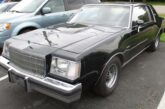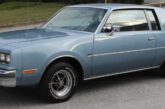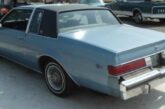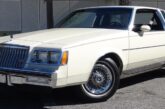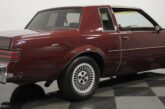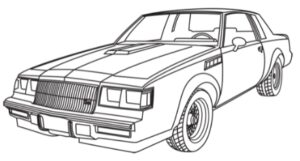1987 Buick Regal, 1987 Buick Regal Limited, 1987 Buick Regal Turbo T, 1987 Buick Regal Turbo T WE4, 1987 Buick Grand National, 1987 Buick GNX.
The year 1987 holds a special place in the annals of American automotive history. It was a time when horsepower was slowly creeping back after the doldrums of the Malaise Era, but few could have predicted that one of the era’s most ferocious performance cars would come not from a Corvette or a Mustang, but from the staid, comfort-oriented showrooms of Buick. 1987 marked the final, glorious year for the rear-wheel-drive G-Body platform, and Buick sent it off with a family of Regal models that ranged from plush personal luxury coupes to a tire-shredding, world-beating monster.
While many enthusiasts lump the turbocharged models together, the 1987 Regal lineup was a surprisingly diverse hierarchy. Understanding the distinctions between the base Regal, the Regal Limited, the Turbo T, the legendary Grand National, and the mythical GNX is to understand a masterclass in platform engineering and marketing. Each car, while sharing the same fundamental DNA, was a unique expression of Buick’s identity.
The Foundation: 1987 Buick Regal and Regal Limited
At the base of this performance pyramid lay the standard Buick Regal and its more luxurious sibling, the Regal Limited. These were the volume sellers, the cars that kept the lights on and provided the platform for the legends to be born.
1987 Buick Regal (Base Model) The entry-point Regal was a handsome, traditionally styled American coupe. Its purpose was to provide comfortable, reliable, and stylish transportation.
- Engine & Drivetrain: The standard engine was a 3.8-liter (231 cubic inch) naturally aspirated V6, producing a modest 110 horsepower and 190 lb-ft of torque. For those desiring a bit more grunt, an optional 5.0-liter (307 cubic inch) Oldsmobile-sourced V8 was available, offering 140 horsepower and 255 lb-ft of torque. Both were paired exclusively with a four-speed automatic transmission.
- Appearance: The base Regal was characterized by its brightwork. It featured a chrome waterfall grille, chrome bumpers, chrome window trim, and often came with wire wheel covers or standard steel wheels. It was the quintessential personal luxury coupe of the 1980s.
- Interior: Inside, buyers could choose between a cloth bench seat for six-passenger capacity or bucket seats with a center console. The dashboard featured a wide, sweeping speedometer and basic instrumentation. Comfort was the priority over sportiness.
- Production: Exact numbers for the base trim are difficult to isolate, but combined production for all non-turbo Regals in 1987 was approximately 45,000 units. These were the common face of the Regal on American roads.
1987 Buick Regal Limited The Limited was not a separate model so much as a premium trim package. It took the base Regal and lavished it with the comfort and luxury features Buick was known for.
- Key Differences: The primary differences were cosmetic and amenity-based. The Limited featured “pillow-top” seating upholstered in plush velour, creating a sofa-like experience. It also included more standard features like power windows, power locks, extensive woodgrain trim on the dash and door panels, and often a padded landau or vinyl roof for a more formal look. The drivetrain options remained identical to the base Regal. The Limited was for the buyer who valued opulence over performance.
The Sleeper: 1987 Buick Regal Turbo T
This is where the Regal family tree begins its aggressive turn. The Turbo T was the enthusiast’s choice for those who valued speed above all else, including image. It was the “wolf in sheep’s clothing,” packing the same potent powertrain as the famous Grand National but without the mandatory sinister attire.
- Engine & Drivetrain: The heart of the Turbo T was the LC2 3.8-liter SFI (Sequential Fuel Injection) turbocharged and intercooled V6. Officially rated at 245 horsepower and 355 lb-ft of torque, these figures were notoriously conservative. This engine transformed the sedate Regal into a straight-line terror capable of 0-60 mph times in the low 6-second range.
- Appearance: This was its defining feature. Unlike the Grand National, the Turbo T could be ordered in a variety of colors and often came with the chrome bumpers and bright trim of a standard Regal. This unassuming appearance made it the ultimate sleeper. A special, lightweight “WE4” package took this a step further, featuring blacked-out trim (like a Grand National) but with lighter aluminum bumper supports and aluminum brake drums, making it slightly quicker than its more famous sibling.
- Options & Interior: Turbo T models featured the full performance suspension, including a larger front sway bar and a rear sway bar. They came standard with analog gauges, including a dash-mounted LED boost gauge. The interior was typically a standard Regal bucket seat setup, though various fabrics and colors were available.
- Production: Approximately 7,800 Regal Turbo models (excluding the Grand National and GNX) were built in 1987. Of those, the highly sought-after WE4 “T-Type” package accounted for just 1,547 units.
The Icon: 1987 Buick Grand National
If the Turbo T was the sleeper, the Grand National was the villain. It took the same mechanical fury and wrapped it in an aesthetic that was pure intimidation. There was no mistaking this car for a standard Regal.
- Engine & Drivetrain: The powertrain was identical to the Turbo T: the LC2 3.8-liter turbocharged V6 with 245 hp and 355 lb-ft of torque, paired with the 200-4R four-speed automatic transmission.
- Appearance: The Grand National was defined by its absence of color. Every single one was painted in menacing Code 19 Black. All exterior trim—the grille, window moldings, bumpers, and side trim—was blacked out. It rode on unique 15-inch aluminum wheels with black chrome-plated steel centers. The only hints of color were the tri-shield Buick emblems and the “Grand National” badges.
- Interior: The interior was also unique. It featured a specific two-tone gray and black cloth interior. A leather-wrapped steering wheel and a console-mounted shifter were mandatory.
- Production: As the final year of the G-Body approached, demand for the Grand National exploded. Buick produced an astounding 20,193 Grand Nationals in 1987, making it the most common of the turbo models but cementing its iconic status.
The Apex Predator: 1987 Buick GNX
As a final, definitive statement, Buick decided to create the “Grand National to end all Grand Nationals.” They sent 547 fully-loaded Grand Nationals to ASC/McLaren Performance Technologies for a transformation into something truly special: the GNX (Grand National Experimental).
- Engine & Drivetrain Modifications: The LC2 V6 was heavily reworked. McLaren added a more efficient Garrett ceramic-impeller turbocharger, a larger and more effective intercooler, a low-restriction exhaust system, and a reprogrammed engine control module (ECM). The official power rating was a comically underrated 276 horsepower and 360 lb-ft of torque. Dyno tests proved the real numbers were well over 300 horsepower and 420 lb-ft of torque, allowing the GNX to rocket from 0-60 mph in a supercar-slaying 4.6 seconds.
- Chassis & Suspension: To handle the immense torque, the GNX received significant chassis upgrades. A unique ladder bar was installed that connected to the rear differential housing, along with a Panhard rod, virtually eliminating the wheel hop that plagued other turbo Regals. The frame was also stiffened with additional bracing.
- Appearance: The GNX was visually distinct. It featured functional heat-extracting vents on the front fenders, subtle fender flares to accommodate larger wheels, and deleted the hood and fender emblems of the Grand National. It rode on special 16-inch black mesh alloy wheels with polished lips.
- Interior: The interior received a serialized plaque on the dashboard, marking its number out of the 547 produced. A unique Stewart-Warner gauge package, including an analog boost gauge, was installed within the dashboard instrument panel.
- Production: Exactly 547 GNX models were produced. With an MSRP of $29,900—nearly double a Grand National—they were instantly collectible and remain the holy grail for Buick enthusiasts today.
In 1987, the Buick Regal was not one car, but a spectrum. It spanned from the comfortable, chrome-adorned cruiser your grandparents drove, to the unassuming Turbo T that could embarrass sports cars at a stoplight, to the iconic black-clad Grand National, and finally, to the factory-built supercar killer known as the GNX. It was a remarkable final act for a platform and an engine that defined an era, leaving behind a legacy of performance that continues to captivate enthusiasts decades later.
.
.






















